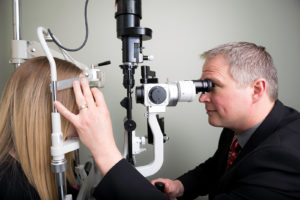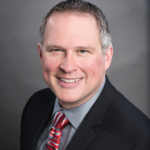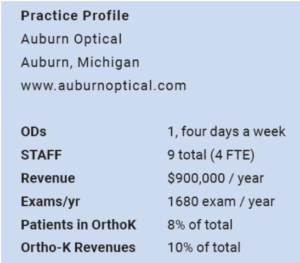SPONSORED CONTENT
By Matthew J. Martin, OD, FIAOMC
I am often asked by fellow doctors how I explain Ortho-K to my patients. It’s simple: I use simple, easy-to- understand terms. Ortho-K is by far the most enjoyable part of my busy practice, and I believe all optometrists should offer it. However, many potential candidates can be lost if they think it is too complicated, too risky, or if they don’t understand how Ortho-K works.
understand terms. Ortho-K is by far the most enjoyable part of my busy practice, and I believe all optometrists should offer it. However, many potential candidates can be lost if they think it is too complicated, too risky, or if they don’t understand how Ortho-K works.
I am a single practitioner in a Michigan town of a little more than 2,000 residents, and I have been able to develop a busy Ortho-K specialty by developing my skills and getting the word
out. At the same time, we provide comprehensive eyecare, manage ocular disease and provide pediatric eyecare and myopia management. Our service is personal, and we are very involved in connecting with community and giving back.
Relate to a Patient’s Experience
In explaining Ortho-K, I start by making direct eye contact with the patient and using open body language to convey sincerity, and openness to mutual discussion. Then I try to find some
common ground or shared experience that we can use as a touchstone for explaining the mechanics of the process.
“Before we begin talking about Ortho-K,” I say, “I want you to think about two glass slides, like the kind you may have had in science class. Placing these two slides on top of each other when they are dry, it is very easy to pull them apart. However, if you place a couple of drops of water between these two slides and try to pull the slides apart it becomes very difficult. The attraction between the two slides when water is present is due to ‘surface tension.’ Surface tension is part of a group of forces called fluid hydraulic forces. Orthokeratology harnesses the hydraulic forces created by the tears of your eye to mold or reshape the cornea.”
Show the Lens & Explain How it Works
I then explain the lens itself: “When you look at an orthokeratology lens (often called a ‘mold’ or a ‘vision retainer’), you may notice that the backside has some curves that are different than you would normally expect to see in a regular, daytime contact lens. These curves have a very
specific role to play. Some of the curves are closer to the cornea than others. It is the difference between the depths of these curves and the cornea, plus your natural tears, that create the fluid hydraulic forces to reshape the cornea overnight.
By reshaping the cornea overnight, orthokeratologists (eye doctors trained to fit Ortho-K lenses), can correct a person’s vision by changing the curvature, and therefore, the power of different regions of the cornea.”
Explain Risk/Benefits & Fees
After this clinical discussion, we explain the risks and benefits of Ortho-K and then we explain fees and set expectations.
Many of my patients are the children of engineers, chemists and health-care professionals, and often the parents want a more in-depth discussion.
If that is the case, I take it one step further by saying, “Orthokeratology physically works by reshaping the clear, flexible cornea with a rigid device; the Ortho-K mold. The effects from overnight orthokeratology are reversible, safe and effective in correcting a person’s vision.” I also refer patients and parents to a “Gentle Vision Shaping System” web page we created to reinforce the initial message.
Explain Process of Myopia Reduction
One of the many advantages of Ortho-K is its ability to reduce the progression of myopia. This reduction in myopia progression is accomplished by correcting the vision differently in the central portion of the eye versus the peripheral area.
 |
Matthew J. Martin, OD, FIAOMC Owns Auburn Optical in Auburn, Michigan. Contact: Auburnoptical@gmail.com |
 |
|
Using overnight Ortho-K, the clinician can correct the central myopia (nearsightedness) while inducingmyopic (near sighted) affect in the peripheral portion of the retina. By inducing myopic (near sighted) correction in the periphery of the eye, the eye is encouraged to stop getting longer. This decrease in elongation can slow, or in some cases, stop the progression of myopia.
Here, I may refer patients and parents to another page on our web site: “Myopia Management for Children” that details the application of specialty contact lenses in slowing the progression of myopia.
Through years of practical application, study and clinical trials, the lenses used in Ortho-K have evolved into very sophisticated methods to reshape a patient’s cornea overnight. Myopia (nearsightedness), hyperopia (farsightedness) and astigmatism can now all be addressed in a safe and reversible manner.”
Being able to explain the concepts of Ortho-K in simple-to-understand language makes a big difference in getting patients to commit to undergo process in your office. Ortho-K is an exciting and growing opportunity for optometry, and being effective and efficient in our presentation is a big key to success.
 |
||
| The Ortho-K Knowledge Bank provides clinical insights and strategies for practice management and business growth. It is created by Review of Optometric Business and Review of Myopia Management for sponsor GP Specialists. | ||
 |
 |
 |






















